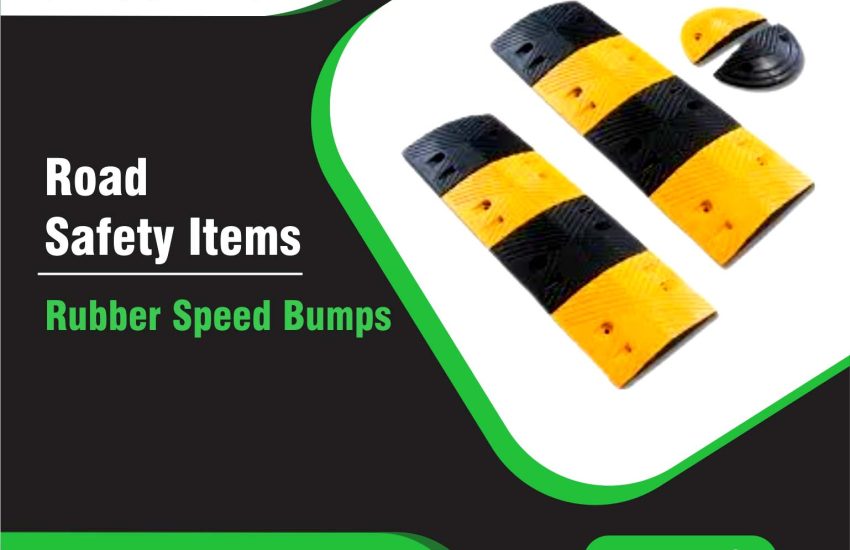Rubber Speed Bumps help slow down vehicles, improve safety, and manage traffic flow. They are ideal for use in parking lots, residential areas, school zones, and industrial sites. Made from durable rubber, these speed bump provide long-lasting performance with easy installation and minimal maintenance. In this article, we will explore the key features, specifications, and benefits of rubber speed bump.
What Are Rubber Speed Bumps?
Rubber speed bumps are raised traffic control devices designed to reduce vehicle speeds. They are made from high-quality rubber, which makes them durable and flexible. These speed bumps help slow vehicles while ensuring minimal damage to both vehicles and the bump itself. Their rubber material absorbs impact and can withstand heavy traffic, making them a popular choice for road safety.
Key Features of Rubber Speed Bumps
- Durable and Weather-Resistant: Rubber speed bump can endure harsh weather conditions, including rain, snow, and extreme temperatures. The rubber material resists wear and tear, ensuring long-lasting effectiveness.
- Easy to Install and Maintain: Installation of rubber speed bump is quick and simple. They do not require complex construction, making them cost-effective. Maintenance is minimal, as rubber is less prone to cracking and damage compared to concrete or asphalt.
- Reflective Markers for Visibility: Many rubber speed bump feature reflective strips to enhance visibility. These markers improve the safety of night-time driving by making the bumps more noticeable.
- Flexible and Resilient: Unlike concrete speed bump, rubber is flexible and resilient. The material absorbs impacts, reducing damage to both vehicles and the speed bump itself. Rubber also adapts to different road surfaces, offering better long-term performance.
- Environmentally Friendly: Many rubber speed bump use recycled rubber, making them an eco-friendly solution. This helps reduce waste while providing a durable and effective traffic-calming option.
- Variety of Sizes and Colors: Rubber speed bump come in various sizes and colors, such as black with yellow reflective strips. You can also order custom colors to suit your specific needs.
Specifications of Rubber Speed Bumps
Here are the key specifications to consider when choosing rubber speed bump:
- Material: Most rubber speed bump are made from high-quality rubber or recycled rubber for durability and shock absorption.
- Dimensions: Rubber speed bump are available in widths ranging from 12 inches to 36 inches. Heights typically range from 2 inches to 4 inches, while lengths vary from 3 feet to 6 feet.
- Weight: The weight of rubber speed bumps typically ranges from 20 lbs to 50 lbs, depending on size. Heavier models offer better stability.
- Reflective Markers: Reflective strips are often placed on the top or sides of the speed bump to increase visibility, especially at night.
- Load Capacity: Rubber speed bump can withstand vehicle loads up to 30 tons, making them suitable for both light-duty and heavy-duty vehicles.
- Modular Design: Many rubber speed bump have a modular design, allowing you to connect multiple sections for longer stretches of road.
- Anti-Slip Surface: The surface of rubber speed bump is often textured to provide better traction for both vehicles and pedestrians.
Benefits of Rubber Speed Bumps
- Cost-Effective: Rubber speed bumps are an affordable option compared to concrete or asphalt alternatives. They offer easy installation and low maintenance costs.
- Improved Safety: By slowing down vehicles, rubber speed bump reduce the risk of accidents and improve safety, particularly in high-traffic areas.
- Long-Lasting Durability: Rubber speed bumps last longer than traditional materials like concrete. Rubber resists cracking and damage, ensuring that your investment lasts for years.
- Non-Damaging to Vehicles: Unlike concrete bumps, rubber speed bump offer a smoother ride, reducing the risk of damage to vehicles.
- Versatility: Rubber speed bump can be used in a variety of settings, from residential roads to commercial areas, parking lots, and school zones. Their flexibility makes them a suitable choice for many environments.
- Eco-Friendly: Many rubber speed bump are made from recycled rubber, contributing to environmental sustainability.
Where to Use Rubber Speed Bumps
- Parking Lots: Use rubber speed bump to control vehicle speed and prevent accidents.
- Residential Areas: Install them in neighborhoods to keep traffic slow and safe.
- School Zones: Place rubber speed bump near schools to ensure the safety of children and pedestrians.
- Commercial Areas: Use them in shopping centers, warehouses, or industrial sites to manage traffic flow.
- Airports and Terminals: Rubber speed bump are ideal for reducing speeds in airport parking lots or transport hubs.
Conclusion
Rubber speed bump provide a durable, cost-effective, and eco-friendly solution for controlling traffic speeds and enhancing safety. Whether for residential areas, parking lots, school zones, or commercial settings, these bumps offer long-lasting performance with minimal maintenance. Their easy installation, flexibility, and reflective markers make them a versatile choice for traffic management. Investing in high-quality rubber speed bump will help improve safety and traffic flow in various environments.


